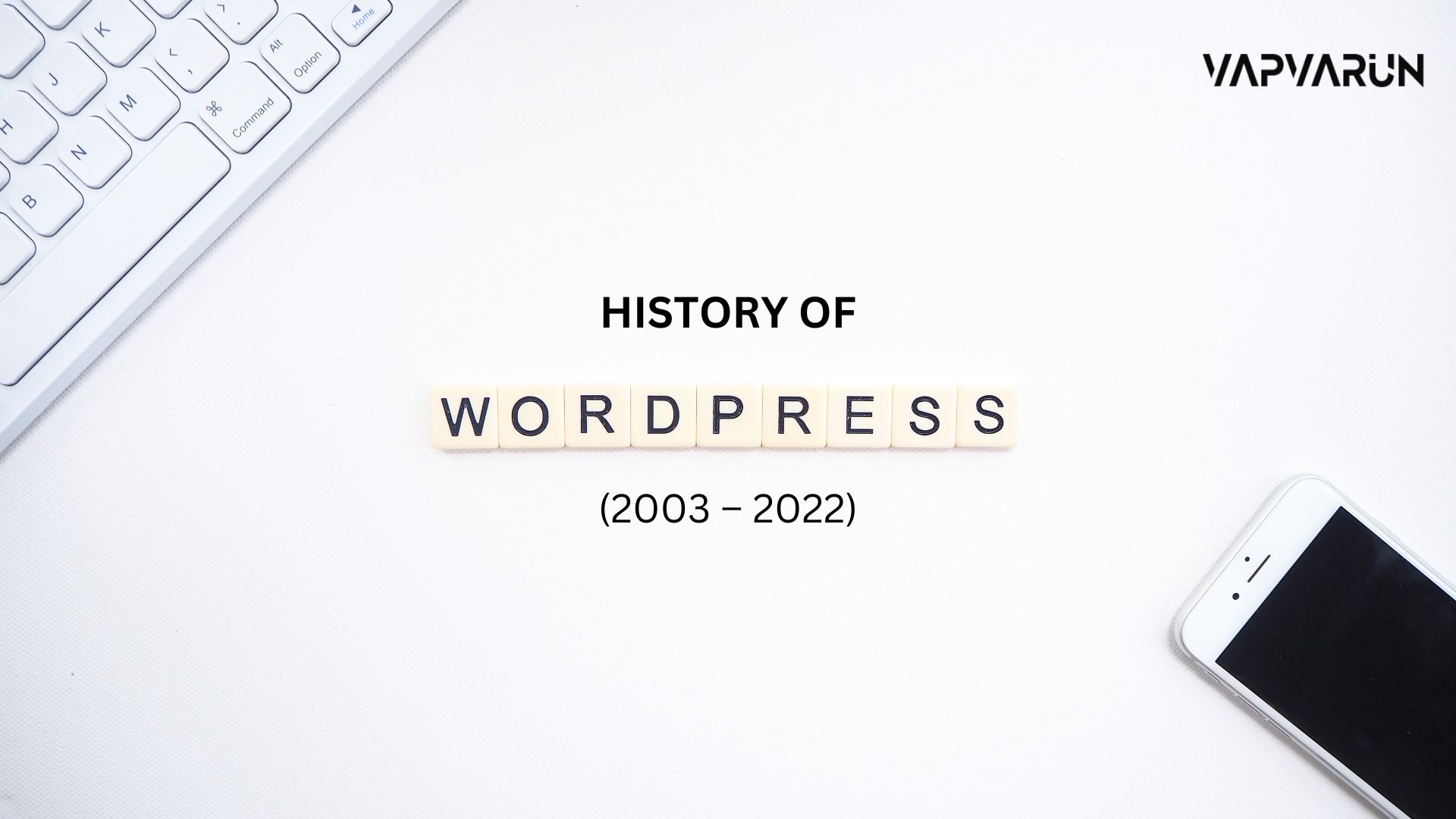In 2003, Matt Mullenweg launched WordPress as a free content management system. Since then, it has grown into a powerful platform with over 100 million active users worldwide.
As we approach the year 2024, WordPress will continue to evolve and become even more popular. It will also play a major role in how businesses operate online. This means that you should learn everything you can about WordPress before 2024 because it will be the most important tool you’ve ever used.
I’m going to cover the history of WordPress from its early days until 2024. I’ll also explain why it matters to you and why you should care about learning how to use it.
What is WordPress and why people use it in 2024?
WordPress is an open-source CMS (Content Management System) designed for publishing websites on the web. Its name comes from “Web-based Word Processor”.
It was created by Matt Mullenweg who wanted to create a simple blogging platform. He released it under a GPL v2 license so anyone could download it and use it for their own projects.
Since its launch in 2003, WordPress has been downloaded millions of times and it’s one of the most widely-used platforms today.
There are many reasons why people choose WordPress:
- Easy to Use – WordPress makes creating a website easy. You don’t need any programming skills or experience to get started.
- Free – The software is completely free to use. There are no hidden costs or fees.
- Open Source – Anyone can contribute to the development of WordPress. They can make changes to the code and submit them back to the community.
- Popular – More than 100 million sites use WordPress today. That’s more than half of all websites on the internet!
- Extensible – WordPress is built using PHP which allows developers to add new features easily.
- SEO Friendly – WordPress is optimized for search engines like Google and Bing. Search engine bots crawl your site and index it quickly.
- Mobile Ready – WordPress works well on mobile devices. Your visitors won’t have to scroll through pages to find what they’re looking for.
History of WordPress (2003)

In 2003, Matt Mullenweg launched WordPress as a free blog hosting service. At first, he hosted his blogs on his personal server but later moved them to a shared host called Bluehost.
He made WordPress very easy to install and configure. His goal was to provide a simple way for people to start building their own websites without having to spend hours configuring servers and databases.
Matt Mullenweg started working on WordPress in 1998 when he was studying computer science at the University of Virginia. He had always enjoyed writing and coding since childhood.
When he graduated college, he decided to build a website for himself. He wrote a small script that allowed him to post text and images to his site. He named this script “Blogger” and it became the first version of WordPress.
After releasing Blogger, Matt continued developing WordPress. In 2001, he released version 1.0 of WordPress.
Over time, he added more features and improved the user interface.
History of WordPress (2004)
In 2004, WordPress went public. It was registered with the United States Patent and Trademark Office as a trademark owned by Automattic Inc.
At the same time, Automattic Inc. bought the domain name wordpress.org. This gave the company full control over the WordPress brand. Automattic Inc. then hired Matt Mullenweg as CEO. Under his leadership, the company grew rapidly.
Since May of 2004, version 1.2 of WordPress included an architecture for plugins. It allowed users and developers to expand the functionality of WordPress by creating custom plugins and then sharing them with the WordPress community.
While WordPress was opening up to the world but something totally different was taking place in the world of blogging at the moment.
The leading market player in the world of blogging tools at the moment that time was Moveable Type. They released new licensing terms that weren’t liked by a lot of people who used their services. They were forced by their users to search for an alternative blogging platform.
History of WordPress (2005-2010)
WordPress began growing rapidly after its release in 2004. By 2005, there were already tens of thousands of active installations. The number of active installations increased every year.
In 2006, WordPress reached one million active installations. In 2007, it passed two million active installations.
By 2008, the number of active installations exceeded three million. In 2009, the number of active installs surpassed four million. In 2010, the number of active WordPress installations hit five million.
The year 2008 an internet design firm called Happy Cog joined the WordPress project to design the new WordPress administration interface. A study of usability was conducted to create the admin interface.
Over the course of the year, new features, such as shortcodes as well as one-click updates, and plugin installation built-in were added to WordPress in various releases.
History of WordPress (2011-2012)
In 2011, the WordPress team launched a major redesign of the WordPress dashboard. This new dashboard featured a cleaner look and feel. It also introduced many new features including drag & drop page builders.
On October 25th, 2012, WordPress 3.5 was released. It brought a number of improvements including better support for mobile devices.
Also in 2012, WordPress announced that they would be offering free hosting for all sites created on WordPress.com.
History of WordPress (2013 – 2014)
In 2013, WordPress 4.0 was released. It introduced a number of new features including the ability to import content from other websites into your blog.
Also in 2013, WordPress announced that they had acquired the popular website builder site Wix. In 2014, WordPress 5.0 was released. This update focused on improving performance and security.
Further refinements were made to the WordPress base throughout the year, with later WordPress 4.0 and WordPress 4.1 releases.
The year 2014 also marked the first time that downloads from non-English countries for WordPress exceeded English downloads.
History of WordPress (2015-2019)

The year 2015 saw WordPress 4.2, 4.3, and 4.4 released. The releases focused on improvements to the localization of WordPress, emoji support as well as theme customizers, and setting up an infrastructure to support the WordPress REST API.
In the identical year, WooCommerce the largest and most well-known WordPress eCommerce plugin was purchased from Automattic (the company started by WordPress co-founder Matt Mullenweg).
In the year 2016, WordPress 4.5, 4.6, and 4.7 were released. Each release brought new features and improvements. The most significant changes throughout the year were more efficient updates for themes and plugins as well as content recovery through browser storage and a custom CSS feature for the theme customizer. At the end of the year, WordPress.org announced that they are actively supporting HTTPS.
In the year 2017, WordPress 4.8 and 4.9 were released. The releases introduced a variety of new widgets that default to adding audio video galleries, image-rich text, as well as HTML. These releases also set the stage for the brand-new WordPress Block Editor.
In the year 2018, WordPress 5.0 was released, which features an entirely new editing experience. The brand new WordPress block editor is codenamed, Gutenberg. Check out our full Gutenberg tutorial on the WordPress Block Editor.
The block editor was the primary focus of WordPress development, even as the WordPress community began to move towards more broad adaptation.
In the year 2019 WordPress began integrating the Site Health project in the core. In WordPress 5.1 as well as 5.2, Site Health started providing users with notifications whenever an earlier PHP version is identified.
It also provided protection for White Screen of Death by permitting users to log in with security in the event of a serious error, and then correct it in The WordPress dashboard.
WordPress Recently (2020-2024)
As we enter 2020, WordPress has continued its growth trajectory. With over 40% of all sites using WordPress, there’s no doubt that this platform is one of the most widely used CMS platforms available today.
With the introduction of Gutenberg, WordPress continues to evolve at a rapid pace. We can expect further enhancements to be rolled out in the coming years.
In the year 2020, The WordPress community was faced with unexpected difficulties due to the outbreak of a pandemic that was spreading across the globe. WordCamp events across the globe were canceled and the community held meetups online.
Fortunately, a lot of WordPress community members and developers were accustomed to and used to remote work. The development continued, and three major WordPress releases ( 5.4, 5.5, and 5.6 ) came out.
Alongside many other improvements that were made, the work started to improve working on the Full Site Editing experience, automatic updates were made available as well as block blocks, directory patterns, along with lazy loading of images were added.
In 2021, the first work started with full editing features for websites using WordPress 5.7 and 5.8. A new feature for templates was added along with a variety of blocks for sites that allow you to easily design templates for the entire site in WordPress. Over the last several many years WordPress continues to enhance the block editor, in an effort to provide a complete editor for sites. Many advances have already been achieved in this space however, for the moment we suggest that users make use of the drag-and-drop WordPress web page editor for greater control of the design.
By 2024, WordPress will remain determined to improve the overall editing experience on the site. The site editing block is to be added with WordPress 5.9 and a variety of WordPress themes will begin to offer an improved editing experience for sites built on blocks editor.
What to expect from WordPress in the future?
We are excited about what lies ahead for WordPress. As we look forward into the next decade, we see a number of exciting developments being planned for WordPress.
One such example is the upcoming release of WordPress 8.0. This release will include a completely redesigned user interface, which will bring a fresh approach to how people interact with their content.
Another exciting addition to WordPress is the ability to create custom post types. These will enable you to add your own unique categories or tags to posts and pages.
Another exciting change is the inclusion of a new theme framework called “Divi”. Divi offers a clean, modern layout that makes it easy to build beautiful websites.
A few more changes include the introduction of a new plugin system, which will help developers to write plugins that can extend functionality beyond the core WordPress code base.
A new version of WordPress will also be released every six months. This means that there will be two versions of WordPress released each year.
Closing Insights – History of WordPress
In conclusion, if you haven’t already done so, please take a moment to check out the history of WordPress from 2003–2024. This timeline will give you a glimpse into the past, present, and future of WordPress. And if you have any questions, feel free to ask us anything in the comments section below. We’d love to hear from you!
Interesting Reads:
10 Web Design Conferences to attend in 2024




